Temple of Heaven Park is located at No. A1, Tiantan Dongli, Dongcheng District, Beijing. It is a UNESCO World Cultural Heritage site and a national 5A-level tourist attraction. As a venue for emperors of the Ming and Qing dynasties to worship heaven, pray for grain, and pray for rain, the Temple of Heaven is the largest existing ancient sacrificial complex in China, covering an area of approximately 2.73 million square meters—equivalent to 400 standard football fields. The architectural layout of the scenic area is in the shape of the Chinese character "hui" (a square within a square), divided into the Inner Altar and the Outer Altar. The main buildings are concentrated in the Inner Altar, including the Hall of Prayer for Good Harvests, the Imperial Vault of Heaven, and the Circular Mound Altar. Their architectural structure embodies the philosophical thought of "heaven is round and earth is square," with blue glazed tiles covering the roofs to symbolize the celestial dome. It is an important material example for studying ancient Chinese cosmology and ritual culture.
History and Culture
First constructed in the 18th year of the Yongle reign of the Ming Dynasty (1420), the Temple of Heaven was initially named "Altar of Heaven and Earth." It was renamed "Temple of Heaven" in the 9th year of the Jiajing reign (1530) and underwent multiple renovations during the Qianlong and Guangxu reigns of the Qing Dynasty. Historically, emperors worshipped heaven here every Winter Solstice, prayed for grain on the first xin day of the first lunar month, and prayed for rain in the first month of summer—these were the highest-level national sacrificial activities in ancient China. Opened to the public as a park in 1918, it is now a comprehensive scenic area integrating cultural relic protection, popular science education, and sightseeing.
The buildings of the Temple of Heaven are rich in symbolic meanings: The Hall of Prayer for Good Harvests stands 38 meters tall, with 28 nanmu pillars inside corresponding to the 24 solar terms, four seasons, and twelve months; the total number of white marble balustrades on the three-tiered Circular Mound Altar is 360, symbolizing the 360 degrees of the celestial circle; the "Echo Wall" of the Imperial Vault of Heaven utilizes acoustic principles to achieve sound reflection, embodying the scientific wisdom of ancient architecture. During the 2008 Beijing Olympic Games, the Temple of Heaven served as a cultural showcase to receive Chinese and foreign guests. In 2018, the conservation and restoration of the painted decorations on buildings such as the Hall of Prayer for Good Harvests were completed, preserving its historical style for over 600 years.
Main Attractions
Hall of Prayer for Good Harvests
As the core building of the Temple of Heaven, the Hall of Prayer for Good Harvests is 38.2 meters high and 24.2 meters in diameter. Its roof is a three-tiered gabled and hip roof covered with blue glazed tiles. The hall has no crossbeams and is supported solely by 28 nanmu pillars: the central 4 "Dragon Well Pillars" (19.2 meters tall) symbolize the four seasons; the 12 golden pillars in the outer circle represent the twelve months; and the additional 12 eave pillars signify the twelve two-hour periods of the day. Built on a three-tiered white marble platform (545 meters in circumference), each tier is adorned with exquisitely carved chi-shaped (mythical sea creature) drainage holes, totaling 1,142, which serve both practical and decorative purposes. This was the venue where Ming and Qing emperors prayed for grain in the first month of spring. Today, the sacrificial scene has been restored inside the hall, displaying cultural relics such as shrines and ritual vessels.
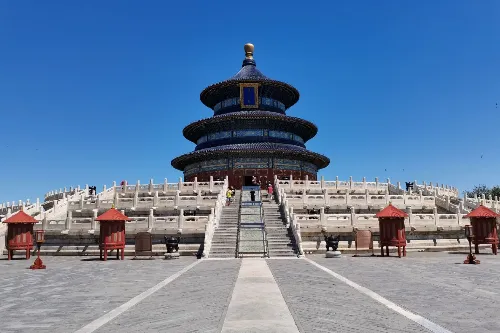
Circular Mound Altar
Built in the 9th year of the Jiajing reign of the Ming Dynasty (1530), the Circular Mound Altar is where emperors worshipped heaven on the Winter Solstice. It consists of three circular tiers of white marble, with the upper tier 30 meters in diameter, the middle tier 50 meters, and the lower tier 70 meters, reaching a total height of 5.17 meters. The stone slabs on the altar surface are arranged in a fan shape, with the "Heavenly Heart Stone" at the center—standing on this stone amplifies sounds and creates a resonance effect. Surrounding the altar are red enclosure walls. There are three sets of steps on the south side and one set each on the east, west, and north sides, with 9 steps per set, symbolizing the "Nine Layers of Heaven." Outside the altar are auxiliary structures such as the Burning Stove (for incinerating sacrifices) and the Burial Pit (for burying sacrificial animals). The existing Burning Stove is approximately 4 meters high and 5 meters in diameter, constructed of green glazed bricks.
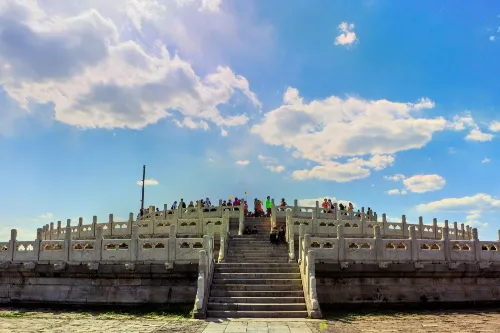
Imperial Vault of Heaven
Constructed in the 17th year of the Jiajing reign of the Ming Dynasty (1538), the Imperial Vault of Heaven houses the spirit tablet of the Supreme Heaven God. It features a single-tiered gabled and hip roof, 19.5 meters high and 15.6 meters in diameter, covered with blue glazed tiles. The hall is supported by 8 golden pillars, with a golden dragon caisson ceiling. Outside the hall is a circular enclosure wall, the famous "Echo Wall" (3.72 meters high and 193.2 meters in circumference). Two people standing behind the east and west auxiliary halls can hear each other clearly when speaking against the wall. The Danbi Stone (imperial steps stone) in front of the hall is carved with patterns of dragons, phoenixes, and sea water, among which the "Two Dragons Playing with a Pearl" relief has a history of over 400 years, boasting smooth lines and a strong three-dimensional effect.
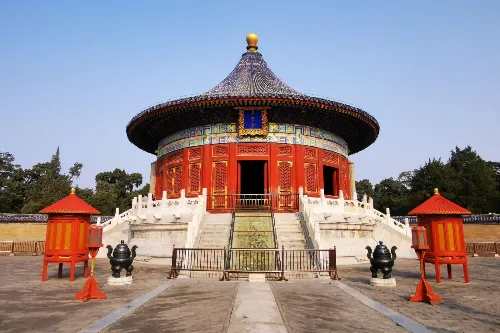
Fast Palace
Built in the 18th year of the Yongle reign (1420), covering an area of nearly 40,000 square meters, the Fast Palace was a dedicated palace for emperors to observe fasting before sacrifices. Three days prior to the ceremony, the emperor would reside here to fast, adhering to strict rules: no meat, no alcohol, no music, no sleeping in inner chambers, no handling judicial affairs, and no visiting the sick or mourning the deceased—maintaining purity and sincerity to show reverence for heaven. The palace includes buildings for rituals, residence, services, and security, such as the Beamless Hall, Bedroom Hall, Bronze Man Stone Pavilion, Bell Tower, guard rooms, and patrol corridors.
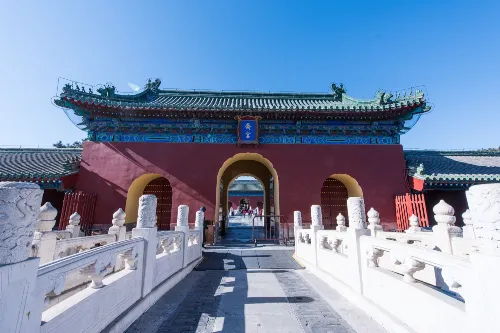
Imperial Music Institute
Originally named the Imperial Music Observatory, it was built in the 18th year of the Yongle reign (1420) and affiliated to the Board of Rites. It served as an institution for teaching and managing the sacrificial music "Zhonghe Shaoyue" (Moderate and Peaceful Music). The institute includes buildings such as the Ningxi Hall, Xianyou Hall, Zhaoyi Suo (Hall of Bright Rows), Muyi Suo (Hall of Quiet Rows), Linglun Hall, and Robe and Costume Warehouse.
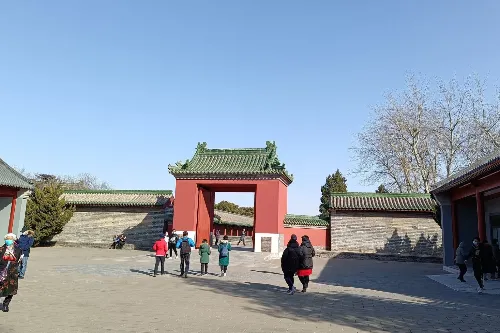
Imperial Heavenly Hall
Constructed in the 18th year of the Yongle reign (1420), this five-bay hall features a gabled roof covered with blue glazed tiles. On a daily basis, it houses the spirit tablets of the "Supreme Heaven God" and the emperors' ancestors, which are moved to the Hall of Prayer for Good Harvests for grand ceremonies. One day before the Prayer for Grain Ceremony, the emperor personally visits to burn incense and perform the ritual of inviting the gods, after which officials from the Board of Rites transport the spirit tablets to the Hall of Prayer for Good Harvests in dragon-shaped palanquins for display.
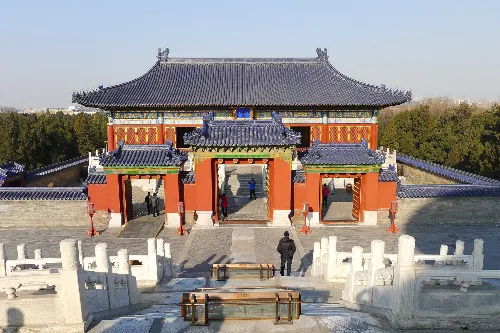
Seventy-Two-Room Corridor
5 meters wide and 295 meters long, consisting of 72 bays, this corridor is also known as the "Seventy-Two Connected Rooms." On the eve of sacrifices, all ritual offerings such as jade, silk, sacrificial animals, grain, and other supplies were transported to the altar along this corridor.
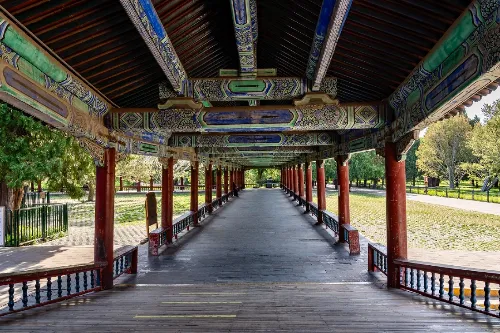
Danbi Bridge
Connecting the Hall of Prayer for Good Harvests and the Circular Mound Altar, the Danbi Bridge is 360 meters long, 28 meters wide, and 4 meters high. It gets its name from the elevated passageway resembling a bridge. Paved with green stone slabs, the bridge is divided into three paths: the central "Divine Path" for the gods, the left "Imperial Path" for the emperor, and the right "Prince's Path" for nobles and ministers. The northern end of the bridge is slightly higher than the southern end, symbolizing "steady progress." Beneath the bridge is an east-west archway called the "Sacrificial Animal Gate," used for transporting sacrificial animals during ceremonies. The existing stone gate is 2.5 meters high and 1.8 meters wide, with 4 door studs.
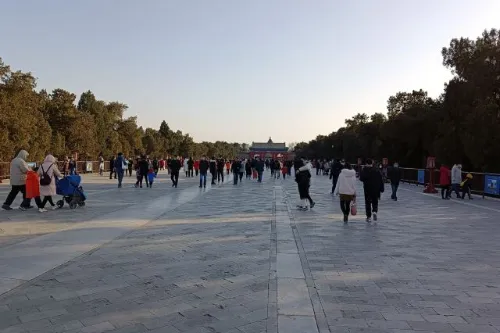
Beamless Hall
Also known as the Main Hall of the Fast Palace, it was built in the 18th year of the Yongle reign (1420). The hall is named for its brick arch structure that supports the roof without beams or brackets. The emperor held relevant rituals here when entering and exiting the Fast Palace. Currently, the central bay of the hall is displayed as it was during the Qianlong reign: the horizontal plaque "Qin Ruo Hao Tian" (Revere the Supreme Heaven) is an imperial calligraphy work by Emperor Qianlong, and the screen and throne are original artifacts, making them extremely precious.
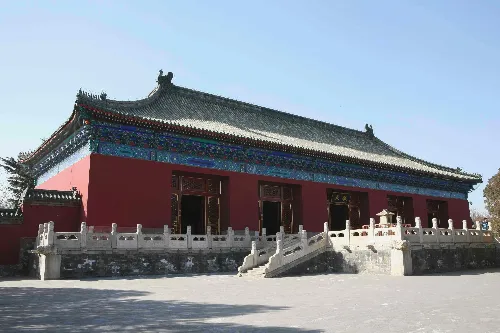
Tour Routes
Recommended Half-Day Tour Route: Enter through the North Gate → Visit the Hall of Prayer for Good Harvests (suggested stay: 1 hour, follow a guide to learn about architectural secrets) → Walk along Danbi Bridge to the Imperial Vault of Heaven (explore the Echo Wall and experience acoustic phenomena, approximately 40 minutes) → Stroll to the Circular Mound Altar (climb the altar to feel the sacrificial rituals, approximately 30 minutes) → Exit through the South Gate. Total duration: about 2.5 hours.
For an in-depth full-day tour, add the Imperial Music Institute (ancient royal music institution, ticket: 10 yuan, including a chime bell performance at 10:00 and 15:00 daily, 20 minutes per show) and the Fast Palace (free of charge, where emperors fasted before worshipping heaven, suggested visit: 1 hour). Also, explore the Hundred Flowers Garden in the Outer Altar (over 2,000 Chinese roses bloom in spring). Total duration: about 4 hours. It is recommended to bring your own water and snacks as there are few snack bars in the park.
Travel Tips
- Recommended visit duration: 3-4 hours. Visit in spring (April-May) to see peonies in the Hundred Flowers Garden, or autumn (October-November) to admire ancient cypresses and red leaves. Avoid the high temperatures in July-August (average daily visitors exceed 80,000).
- Wear comfortable, non-slip shoes as the park has many stone paths, some of which are worn and slippery. Bring a sunhat in summer (no shade around the Hall of Prayer for Good Harvests) and scarves/gloves in winter (no heating in the halls, indoor temperature around 5°C).
- Free volunteer-guided tours are available every Tuesday and Thursday at 9:00 AM, gathering at the North Gate Tourist Center.
- Photography spots: Capture the full view of the Hall of Prayer for Good Harvests from the side of its east auxiliary hall; take an overhead shot of the radial stone slabs from the Heavenly Heart Stone on the Circular Mound Altar; photograph the curved Echo Wall from the west side of the Imperial Vault of Heaven; and shoot the sense of extension of the central axis from the middle section of Danbi Bridge.
- Dining recommendations: Try breakfast at Laociqikou Douzhi Shop near the North Gate, or lunch at Nanmen Shuanrou (South Gate Hot Pot) near the South Gate. Average consumption: 50-150 yuan per person. Only simple fast-food restaurants are available at the North and East Gates inside the park, with relatively high prices.
Notes
- The park implements a "one-way tour" system: enter through the North Gate and exit through the South Gate, or enter through the West Gate and exit through the East Gate to avoid backtracking. Tourist maps can be obtained at the Tourist Center.
- Pets and drones are prohibited in the park. Touching cultural relics is not allowed inside buildings such as the Hall of Prayer for Good Harvests. Flash photography is forbidden to avoid damaging the painted decorations.
- The steps of the Circular Mound Altar are relatively high (9 steps per tier). Elderly visitors and children should exercise caution. There are no handrails on both sides of Danbi Bridge; walk close to the inner side and avoid crowding or pushing.
- Combination tickets are valid for one-time entry to all attractions—re-entry is not permitted after exiting. The last electric shuttle bus departs at 18:00; those who miss it must walk out of the park.
- In case of severe weather such as heavy rain or strong winds, the second-floor platform of the Hall of Prayer for Good Harvests will be temporarily closed, and staff will guide visitors to indoor areas such as the Imperial Vault of Heaven. The park closes 30 minutes earlier on snowy days in winter.
Transportation
- Subway: Take Line 5 to "Tiantan East Gate" Station (Exit A1), then walk about 500 meters to the East Gate. Take Line 8 to "Tianqiao" Station (Exit C), then walk about 800 meters to the West Gate.
- Bus: North Gate: Buses 6, 34, 35, 36, 72, 128 to "Tiantan North Gate" Station; East Gate: Buses 6, 34, 35, 36, 72, 128 to "Tiantan East Gate" Station; South Gate: Buses 36, 53, 122, 141, 17, 25, 59 to "Tiantan South Gate" Station; West Gate: Buses 2, 20, 35, 36, 53, 71, 120, 126 to "Tiantan West Gate" Station.
- Self-driving: Parking is available at Tiantan Dongli Parking Lot (about 100 spaces, 15 yuan/hour) and Tiantan South Gate Parking Lot (about 80 spaces, 12 yuan/hour) near the park. It is recommended to visit on weekdays as parking is in high demand on weekends.
Opening Hours
Open year-round. Park gate hours: Peak season (April-October) 6:00-21:00 (last entry at 20:30); Off-season (November-March) 6:30-21:00 (last entry at 20:00). Attraction hours: Peak season 8:00-17:30 (last entry at 17:00); Off-season 8:00-16:30 (last entry at 16:00).
The park is free to the public on the first Saturday of each month (reservation required, excluding attractions). The Hall of Prayer for Good Harvests is free for visitors over 60 years old every Friday afternoon.
During winter (December-February), ancient cypresses on both sides of Danbi Bridge are decorated with red lanterns, and the park is open until 20:00 at night, making it ideal for night photography.
Tickets
Combination Ticket (including park entry): 34 yuan/person; Park Entry Ticket only: 15 yuan/person.
Search for the official WeChat public account "天坛公园官方购票平台" to get the latest updates or purchase tickets online.
Online Booking
Click here to jump to the Trip.com ticketing platform for ticket purchase.


